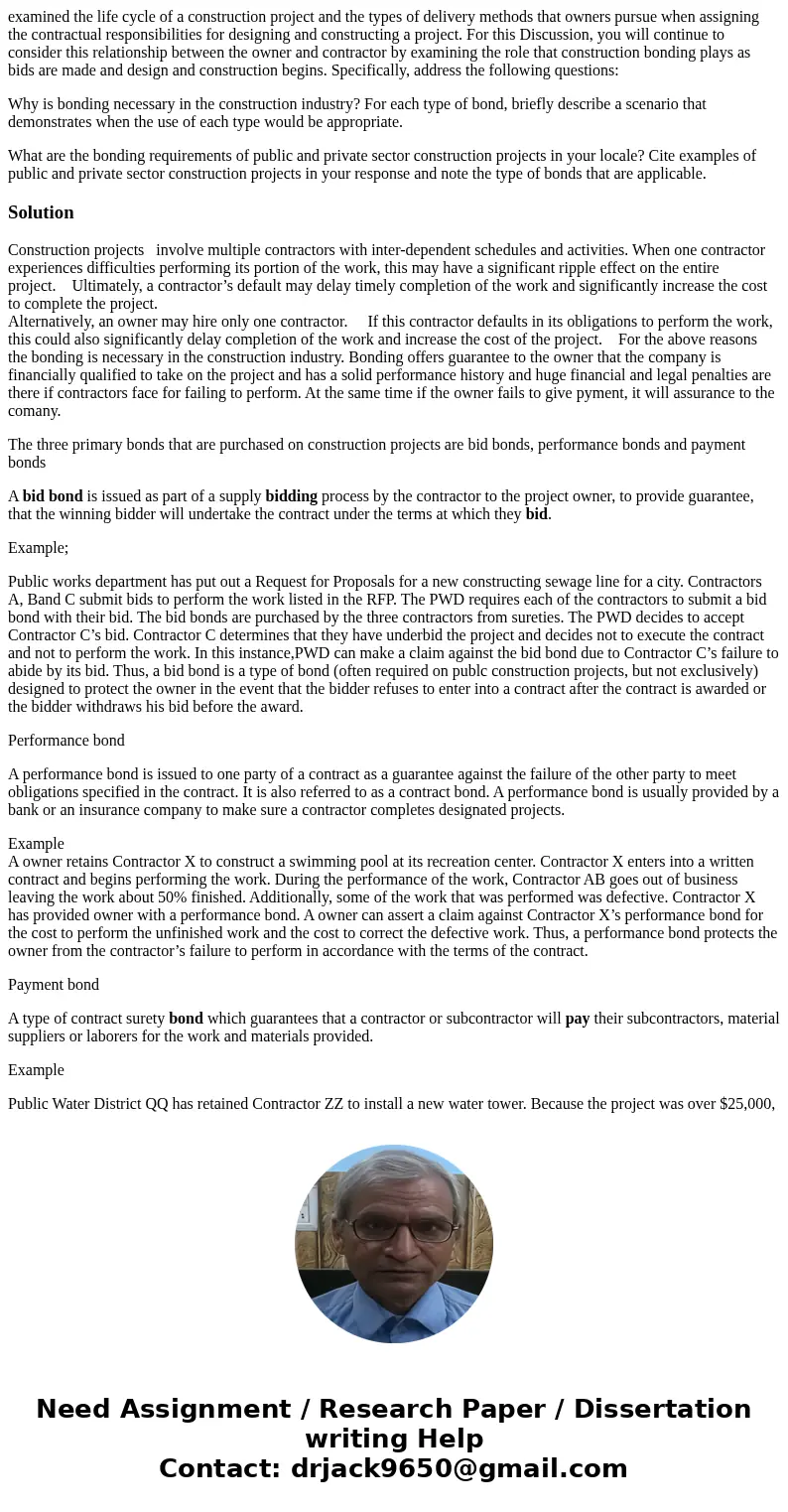examined the life cycle of a construction project and the ty
examined the life cycle of a construction project and the types of delivery methods that owners pursue when assigning the contractual responsibilities for designing and constructing a project. For this Discussion, you will continue to consider this relationship between the owner and contractor by examining the role that construction bonding plays as bids are made and design and construction begins. Specifically, address the following questions:
Why is bonding necessary in the construction industry? For each type of bond, briefly describe a scenario that demonstrates when the use of each type would be appropriate.
What are the bonding requirements of public and private sector construction projects in your locale? Cite examples of public and private sector construction projects in your response and note the type of bonds that are applicable.
Solution
Construction projects involve multiple contractors with inter-dependent schedules and activities. When one contractor experiences difficulties performing its portion of the work, this may have a significant ripple effect on the entire project. Ultimately, a contractor’s default may delay timely completion of the work and significantly increase the cost to complete the project.
Alternatively, an owner may hire only one contractor. If this contractor defaults in its obligations to perform the work, this could also significantly delay completion of the work and increase the cost of the project. For the above reasons the bonding is necessary in the construction industry. Bonding offers guarantee to the owner that the company is financially qualified to take on the project and has a solid performance history and huge financial and legal penalties are there if contractors face for failing to perform. At the same time if the owner fails to give pyment, it will assurance to the comany.
The three primary bonds that are purchased on construction projects are bid bonds, performance bonds and payment bonds
A bid bond is issued as part of a supply bidding process by the contractor to the project owner, to provide guarantee, that the winning bidder will undertake the contract under the terms at which they bid.
Example;
Public works department has put out a Request for Proposals for a new constructing sewage line for a city. Contractors A, Band C submit bids to perform the work listed in the RFP. The PWD requires each of the contractors to submit a bid bond with their bid. The bid bonds are purchased by the three contractors from sureties. The PWD decides to accept Contractor C’s bid. Contractor C determines that they have underbid the project and decides not to execute the contract and not to perform the work. In this instance,PWD can make a claim against the bid bond due to Contractor C’s failure to abide by its bid. Thus, a bid bond is a type of bond (often required on publc construction projects, but not exclusively) designed to protect the owner in the event that the bidder refuses to enter into a contract after the contract is awarded or the bidder withdraws his bid before the award.
Performance bond
A performance bond is issued to one party of a contract as a guarantee against the failure of the other party to meet obligations specified in the contract. It is also referred to as a contract bond. A performance bond is usually provided by a bank or an insurance company to make sure a contractor completes designated projects.
Example
A owner retains Contractor X to construct a swimming pool at its recreation center. Contractor X enters into a written contract and begins performing the work. During the performance of the work, Contractor AB goes out of business leaving the work about 50% finished. Additionally, some of the work that was performed was defective. Contractor X has provided owner with a performance bond. A owner can assert a claim against Contractor X’s performance bond for the cost to perform the unfinished work and the cost to correct the defective work. Thus, a performance bond protects the owner from the contractor’s failure to perform in accordance with the terms of the contract.
Payment bond
A type of contract surety bond which guarantees that a contractor or subcontractor will pay their subcontractors, material suppliers or laborers for the work and materials provided.
Example
Public Water District QQ has retained Contractor ZZ to install a new water tower. Because the project was over $25,000, Contractor ZZ was required by the Water District to provide a payment bond. Contractor ZZ completed the work, but failed to pay Subcontractor X for its work. Subcontractor X cannot pursue any claim against the Water District. However, Subcontractor X can assert a claim against the payment bond for the amount owed to it for its work on the project. Thus, a payment bond is designed to provide security to subcontractors and materials suppliers to ensure payment for their work, labor and/or materials on the project.
Bonding requirements of public and private sector construction projects
Most public construction projects require contractors or subcontractors to secure their bids by providing bonds which serve as a means of legal and financial protection to the client. (bid bond)
All projects valued over $25,000 require performance and payment bonds. A bid bond should be submitted on all jobs that require payment and performance bonds. Jobs valued under $100,000 must allow contractors to submit a cash deposit rather than a bid bond


 Homework Sourse
Homework Sourse